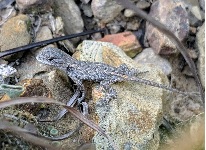 |
Prairie Lizard Video
Want to Contribute a Video of a Prairie Lizard?
Email Us
|
|
|
 |
 |
 |
 |
 |
 |
|
Prairie Lizard (Sceloporus consobrinus)
Description: The adult Prairie Lizard ranges from 4 to 7 inches in total length. The tail is over half of the total length of individuals. The background color is light brown or light gray, and individuals have a wide gray middorsal stripe. A pale cream or white dorsolateral stripe runs from the neck to the base of the tail and is typically bordered by a rust-colored stripe with variable black or white markings. Sides are reddish-brown. Scales are large, keeled, and overlapping, giving it a rough, spiny appearance and texture. Although similar in appearance to the Common Sagebrush Lizard, the Prairie Lizard has keeled, overlapping scales on the thigh, posterior to the femoral pores (Common Sagebrush Lizards have small, non-keeled, non-overlapping scales here). Adult males are easily differentiated from females by two bright blue patches on the underside that females lack. Both males and females have a row of femoral pores on the underside of each thigh, which are enlarged in adult males. Juveniles are similar in appearance to adults, but juvenile males lack the blue patches that they acquire with sexual maturity.
Habitat: This species can be found in grasslands with sparse vegetation, yuccas, and sandy soils. Additionally, sandy regions with large areas of sand prairie and sand dunes are used by Prairie Lizards. Generally, this species is terrestrial but can climb logs, fence posts, and other vertical surfaces.
Range: This species occurs throughout much of the Great Plains, from Texas and New Mexico north to South Dakota and east to Louisiana, Arkansas, Missouri, and Illinois.
Diet: Diet is dominated by insects, spiders, and other arthropods.
Reproduction: The reproductive season is from March into early August. Courtship and mating begin in the spring soon after the adults emerge from winter retreats and continue into summer. Males are territorial and display their bright blue throats and bellies while head-bobbing and performing pushups. This behavior wards off other males, especially during the competitive mating season.
Egg laying generally occurs from mid-April into late July. A gravid female will locate a suitable nesting site, such as a small patch of loose dirt or an old sawdust pile, and dig a flask-shaped hole. She deposits her eggs within the hole, covers them with dirt, and abandons the nest. Incubation generally lasts 6 to 8 weeks, and hatchlings begin to emerge from the nest in midsummer through early autumn.
A clutch comprises 4 to 17 eggs. Females can produce eggs when less than one year old, but only one clutch of eggs is laid the first season. Two-year-old females produce two clutches per season and are the major contributors to the population. The first clutch is laid during late May or early June, and the second, if produced, is laid in July.
The eggs hatch in late July and August. The incubation time can vary. When the second clutch of eggs is delayed by being retained in the female, the incubation time is shortened; this allows the young to hatch sooner and have time to grow before the first frost.
Status: Listed as Least Concern in view of the large and relatively stable extent of occurrence, area of occupancy, number of subpopulations, and population size. A split of this species into multiple species has been proposed, but further study is needed to clarify the geographic and taxonomic scope of the new species. Adopting such a split likely would not result in any species that are not Least Concern.
»» Kingdom: Animalia - Animals
»» Phylum: Chordata - Chordates
»» Subphylum: Vertebrata - Vertebrates
»» Class: Reptilia - Reptiles
»» Order: Squamata - Lizards
»» Family: Phrynosomatidae - North American Spiny Lizards
»» Genus: Sceloporus
»» Species: Sceloporus consobrinus - Prairie Lizard
This article uses material from the Wikipedia article "Sceloporus consobrinus", which is released under the Creative Commons Attribution-Share-Alike License 3.0. Content may have been omitted from the original, but no content has been changed or extended.
|
|













